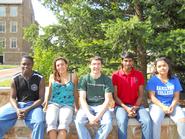
The chemicals in pharmaceutical drugs must be carefully controlled to ensure that only one specific 3-D arrangement of each molecule ends up in the drug. However, separating very similar chemicals from a solution can pose significant challenges to researchers. This summer Shawon Akanda ’12, Barsha Baral ’13, Allison Boyaris ’12 and Hillary “Kip” Langat ’13, are working under Visiting Assistant Professor of Chemistry Timothy Chapp to separate phosphine enantiomers. Their project is titled “Enantioselective Liquid-Liquid Extraction.”
Akanda’s, Boyaris' and Langat’s summer research was funded through the Edward and Virginia Taylor Fund for Student/Faculty Research in Chemistry, established in 2008 through a gift from Ted ’46 and Virginia to inspire students interested in chemical research and to facilitate their work with outstanding faculty.
Two molecules can share the same general structure but have different arrangements in 3-D space. If two such molecules are mirror images of one another, they are called enantiomers. Chapp’s group is working to separate the enantiomers of phosphines, or a phosphorus atom with one lone pair of electrons that is bound to three organic groups.
Phosphines can be made water soluble, and so the group is trying to create a guest-host complex where a large host molecule is added to an aqueous, or water-based, solution containing two phosphine enantiomers. The goal is to synthesize a host that binds to only one enantiomer, which the host molecule would then carry into an organic layer. The aqueous and organic layers can then be separated, with only one enantiomer remaining in each of the layers.
Boyaris, a chemistry major, and Langat, an economics and chemistry double major, are synthesizing the phosphines for the project. They are testing several different phosphines, each of which is synthesized in enantiomeric pairs. During the synthesis process, Boyaris and Langat must keep their products completely dry. This means that until the phosphines are completed, they must be kept under inert gasses and their glassware must be flame-dried. The two rely heavily on phosphorus NMR spectroscopy to ensure that each step in their synthesis has been carried out successfully.
Akanda, a chemistry and art double major, and Baral, a biochemistry and art double major who joined the group recently, are working to synthesize host molecules that maximize efficiency at separating the enantiomers. The enantioselectivity of the host molecule, or the molecule’s preference to bind to only one enantiomer, depends on the shape and structure of the host, and so Akanda and Baral are experimenting with different host molecules to see which are the most selective. They employ NMR, IR and LC-MS techniques to test their results.
The students have enjoyed their previous work with Professor Chapp, and they look forward to gaining inorganic chemistry experience in Chapp’s lab. This particular method of separating enantiomers is also relatively “green,” as the host compounds that Akanda and Baral are synthesizing can often be detached from the guest and reused, minimizing waste and energy that would have gone into recreating the hosts.
The group is traveling to Colgate later in the summer to present their results, which are applicable in pharmaceutical work. Because enantiomers have nearly identical properties, their separation necessitates innovative thinking. Chapp’s lab group is helping to reveal new methods of separating phosphine enantiomers, furthering current knowledge in this field.
Hillary Langat is a graduate of Tenwek High School in Southwest Kenya; Allison Boyaris graduated from St Ignatius College Prep (Chicago); Shawon Akanda is a graduate of Manhattan Center for Science and Mathematics (N.Y.); Barsha Baral graduated from Grover Cleveland High School in Queens (N.Y.).
Posted August 14, 2011
